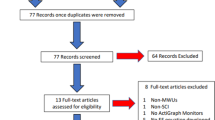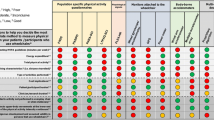Abstract
Patients with a spinal cord injury (SCI) who have been using wheelchairs for a long time are prone to obesity due to decreased physical activity; this often develops into secondary complications, such as metabolic or cardiovascular diseases. Therefore, these patients should be provided with relevant information, such as their calorie consumption, to address issues related to obesity and encourage exercise. This study aimed to develop an estimation formula for the metabolic equivalent of task (MET) and energy expenditure (EE) based on the intensity of wheelchair driving in SCI patients. We analyzed the energy expenditure of 40 patients with SCI while driving the wheelchair at low, moderate, and high intensities on a treadmill using a portable gas analyzer. The MET and EE equations were calculated based on wheelchair speed, and the consistency between the estimated and the measured MET and EE values was then analyzed. Consequently, the estimated METs were 3.4, 4.6, and 6.0 at wheelchair driving speeds of 2.2 km/h, 3.5 km/h, and 5.1 km/h, respectively, and the measured MET was found to be equivalent to moderate and high-intensity physical activities. In addition, the estimated and measured values of the developed MET and EE equations exhibited high reliability based on the intra-class correlation coefficient of 0.958 (95% CI 0.939–.971, p = 0.000) with a limit of agreement from −3.29 to 2.84 kcal. The developed estimation formula can aid in predicting the calorie consumption related to the wheelchair activity of disabled people with SCI.



Similar content being viewed by others
References
Maggioni, M., et al. (2003). Body composition assessment in spinal cord injury subjects. Acta Diabetologica, 40(1), s183–s186.
Popp, W. L., et al. (2018). Estimation of energy expenditure in wheelchair-bound spinal cord injured individuals using inertial measurement units. Frontiers in Neurology, 9(478), 1–15.
Buchholz, A. C., & Pencharz, P. B. (2004). Energy expenditure in chronic spinal cord injury. Current Opinion in Clinical Nutrition & Metabolic Care, 7(6), 635–639.
Kang, D.-W., et al. (2012). Prediction of energy consumption according to physical activity intensity in daily life using accelerometer. International Journal of Precision Engineering and Manufacturing, 13(4), 617–621.
Kressler, J., et al. (2018). Accuracy and precision of consumer-level activity monitors for stroke detection during wheelchair propulsion and arm ergometry. PLoS ONE, 13(2), e0191556.
Coulter, E. H., et al. (2011). Development and validation of a physical activity monitor for use on a wheelchair. Spinal Cord, 49(3), 445–450.
Gendle, S. C., et al. (2012). Wheelchair-mounted accelerometers for measurement of physical activity. Disability and Rehabilitation Assistive Technology, 7(2), 139–148.
Buchholz, A. C., McGillivray, C. F., & Pencharz, P. B. (2003). Differences in resting metabolic rate between paraplegic and able-bodied subjects are explained by differences in body composition. The American Journal of Clinical Nutrition, 77(2), 371–378.
Ainsworth, B. E., et al. (1993). Compendium of physical activities: classification of energy costs of human physical activities. Medicine & Science in Sports & Exercise, 25(1), 71–80.
Collins, E. G., et al. (2010). Energy cost of physical activities in persons with spinal cord injury. Medicine & Science in Sports & Exercise, 42(4), 691–700.
Conger, S. A., & Bassett, D. R. (2011). A compendium of energy costs of physical activities for individuals who use manual wheelchairs. Adapted Physical Activity Quarterly, 28(4), 310–325.
Gater, D. R., Jr. (2007). Obesity after spinal cord injury. Physical Medicine and Rehabilitation Clinics of North America, 18(2), 333–351.
Kiuchi, K., et al. (2014). Preliminary study for the assessment of physical activity using a triaxial accelerometer with a gyro sensor on the upper limbs of subjects with paraplegia driving a wheelchair on a treadmill. Spinal Cord, 52(7), 556–563.
Pescatello, L.S., D. Riebe, and P.D. Thompson. (2014). ACSM's guidelines for exercise testing and prescription. Lippincott Williams & Wilkins.
Pate, R.R., et al. (1995). Physical activity and public health: a recommendation from the Centers for Disease Control and Prevention and the American College of Sports Medicine. Jama, 1995. 273(5), 402–407.
Medicine, A.C.o.S. (2013). ACSM's guidelines for exercise testing and prescription. Lippincott Williams & Wilkins.
Hiremath, S.V. and D. Ding. (2011). Regression equations for RT3 activity monitors to estimate energy expenditure in manual wheelchair users. Annual International Conference of the IEEE Engineering in Medicine and Biology Society, 7348–7351.
Davis, G. M., et al. (2010). Energy expenditures during wheelchair propulsion derived from a body-worn sensor versus indirect calorimeter. Medicine & Science in Sports & Exercise, 42(5), 335.
Andersen, R. E., et al. (2018). Accuracy of two generic prediction equations and one population-specific equation for resting energy expenditure in individuals with spinal cord injury. Canadian Journal of Dietetic Practice and Research, 79(4), 164–169.
Acknowledgements
This research was supported by the Technology Innovation Program (10084565, Development of Smart Wheelchair Power-assist Module for Outdoor Activity and Off-road Driving for the Disabled), funded by the Ministry of Trade, Industry and Energy (MOTIE, Korea).
Author information
Authors and Affiliations
Corresponding author
Additional information
Publisher's Note
Springer Nature remains neutral with regard to jurisdictional claims in published maps and institutional affiliations.
Rights and permissions
About this article
Cite this article
Kang, J.S., Kim, G.S., Hong, EP. et al. Development of an Energy Expenditure Estimation Formula Associated with the Wheelchair Activity of Disabled People with a Spinal Cord Injury. Int. J. Precis. Eng. Manuf. 22, 1097–1104 (2021). https://doi.org/10.1007/s12541-021-00482-5
Received:
Revised:
Accepted:
Published:
Issue Date:
DOI: https://doi.org/10.1007/s12541-021-00482-5




